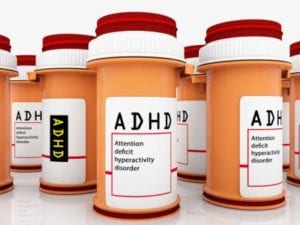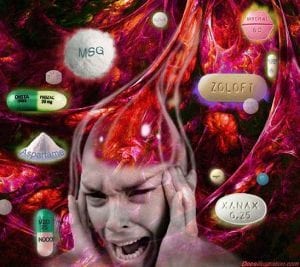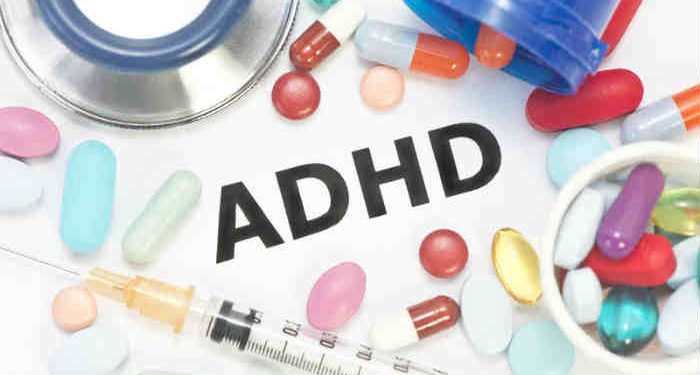Difficulty concentrating, impulsiveness, excessive energy and inability to sit are some of the most common symptoms of what has been unscientifically defined as ADHD. Western medicine focuses on prescription medications that don’t cure ADHD and instead only suppress some of the symptoms. In addition, these medications are linked to personality changes, suicidal thoughts and other disturbing side effects such as delayed growth, sleep problems, decreased appetite and heart problems. To back up dodgy research, ADHD industry insiders produce consensus statements, where like-minded, self appointed ‘experts’ agree that ADHD is real and amphetamines are a safe and effective treatment.
 As a central nervous system stimulant, Ritalin can cause nervousness, agitation and anxiety, all of which are already symptoms of ADHD. (source) The amphetamine, Adderall, is one of the most prescribed medications today and is known to be highly addictive. On top of the ones listed above, other side effects include hallucinations, muscle twitches, high blood pressure and extreme mood swings. (source)
As a central nervous system stimulant, Ritalin can cause nervousness, agitation and anxiety, all of which are already symptoms of ADHD. (source) The amphetamine, Adderall, is one of the most prescribed medications today and is known to be highly addictive. On top of the ones listed above, other side effects include hallucinations, muscle twitches, high blood pressure and extreme mood swings. (source)
Good science is not about quantity of research, it is about quality. None of the thousands of papers cited by the ADHD industry prove that ADHD is a biochemical imbalance or that amphetamines or Strattera are safe and effective treatments.
When asked for proof of its validity, ‘ADHD experts’ will often respond that there are thousands of scientific papers that support their claims. However, when asked which one of these scientific papers has robust methodology, they cannot identify a single, long term, research paper that stands scrutiny. The ADHD industry makes up for a lack of quality research, supporting their arguments, by producing a mass of short term, poor quality research. To back up this dodgy research ADHD industry insiders produce consensus statements, where like-minded, self appointed ‘experts’ agree that ADHD is real and amphetamines are a safe and effective treatment.
Oregon Study
Compelling evidence of the poor quality of this research was demonstrated in 2005 through the Oregon Health and Science University ADHD Drug Effectiveness Review Project. The review was commissioned by fifteen U.S. states in order to determine which ADHD drugs were the safest and the most cost effective.[1] The 731-page report analyzed ‘virtually every investigation ever done on ADHD drugs anywhere in the world’.[2] Of the 2,287 studies analyzed ‘the group rejected 2,107 investigations as being unreliable, and reviewed the remaining 180 to find superior drugs’.[3] Instead of being able to make objective comparisons of the safety and effectiveness of different ADHD drugs, the review was ‘severely limited’ by a lack of studies measuring ‘functional or long-term outcomes’.[4]
The review concluded that ‘evidence on the effectiveness of pharmacotherapy for ADHD in young children is seriously lacking’[5] and that there was ‘no evidence on long-term safety of drugs used to treat ADHD in adolescents’.[6] The review also found that ‘good quality evidence on the use of drugs to affect outcomes relating to global academic performance, consequences of risky behaviours, social achievements, etc. is lacking’.[7] It was also critical of the lack of research into the possibility that some ADHD drugs could stunt growth[8] and found that the evidence that ADHD drugs help adults was ‘not compelling’.[9] Overall, the report ascertained that the body of evidence was of ‘poor quality’.
MTA Study
Up until 2007 probably the most commonly referred to source justifying the use of drug therapy was the Multimodal Treatment Study for Attention Deficit Hyperactivity Disorder (AKA the MTA Study). While there were several methodological flaws, notably a lack of a placebo and blind raters, the MTA Study did follow a significant number of children.[10] In 1999 after conducting the first fourteen months of the study the authors concluded that, ‘carefully crafted medication management was superior to the behavioural treatment and to routine clinical care that included medication’.[11] It was described as ‘one of the first studies to demonstrate benefits of multimodal and pharmacological interventions lasting longer than 1 year’.[12]
However, in 2007, after an analysis of the three-year follow-up to the MTA Study, one of the scientists who ran the study, Professor William Pelham, concluded:
‘I think we exaggerated the beneficial impact of medication in the first study. We had thought that children medicated longer would have better outcomes. That didn’t happen to be the case…In the short run [medication] will help the child behave better, in the long run it won’t. And that information should be made very clear to parents.’[13]
The three-year data also showed that children using behavioral therapy alone had ‘a slightly lower rate of substance abuse’ and that ‘the (medicated) children had a substantial decrease in their rate of growth, so they weren’t growing as much as other kids in terms of both their height and their weight’.[14]
The fact that the fourteen-month data supported the use of stimulants and the three-year data did not, is also entirely in keeping with the commonsense proposition that children mature at different rates and ‘that brains of children with ADHD, rather than developing abnormally (as in autism), mature later’.[15] It also supports the idea that while nothing affects behavior as fast as behavior-altering medications, amphetamines simply mask symptoms and do nothing to address their cause.
World’s First Long-Term Data – Raine Study Review
The MTA Study hinted at sustained harm (stunted growth and drug abuse), however it only followed children for three years, which is hardly long term. The data that showed significant evidence of long-term harm came from the Western Australian Ministerial Implementation Committee on ADHD (MICADHD) Raine Study Review. The Review studied the data provided by the Raine Study, a long-term, large-scale, generalized study into children’s health and well-being conducted at Perth’s King Edward Memorial Hospital.[16] Published in February 2010 it provided the world’s first independent data on the long-term effects (nine years) of psycho-stimulant medication.[17]
The two most significant findings of the MICADHD Raine Study Review were:
- Long-term cardiovascular damage:
‘The most noteworthy finding in the study was the association between stimulant medication and diastolic blood pressure. Compared to not receiving medication the consistent use of stimulant medication was associated with a significantly higher diastolic blood pressure (of over 10mmHg). This effect did not appear to be solely attributable to any short-term effects of stimulant medication, as when comparing groups who were currently receiving medication, it was found that those who had consistently received medication at all time points had a significantly higher mean diastolic blood pressure than those who had not consistently received medication in the past (difference of 7mmHg). These findings indicate there may be a lasting longer term effect of stimulant medication on diastolic blood pressure above and beyond the immediate short-term side effects.’[18]
- School failure:
‘In children with ADHD, ever receiving stimulant medication was found to increase the odds of being identified as performing below age-level by a classroom teacher by a factor of 10.5 times.’[19]
In addition the report indicated that there was a marginally negative outcome for both ADHD symptoms (inattention and hyperactivity) and depression with the long-term use of stimulant medication.[20]
The finding that amphetamine use may permanently raise diastolic blood pressure is of great significance. It had been previously recognized that while stimulants were in the patient’s system, heart rate and blood pressure were elevated, leading to the associated risks of heart attacks and strokes. But it was assumed that when the short-term stimulant effects wore off the cardiovascular system returned to normal.
 The most startling finding was that past stimulant use increased the probability of an ADHD child failing school by a massive 950 percent. This finding completely undermines the hypothetical basis of medicating for ADHD. As stated in the MICADHD report, the basis of the belief that amphetamines have long-term benefits are short-term studies, which ‘indicate that immediate management of ADHD symptoms allows children to function more effectively within a classroom. It is hypothesised that this makes children more available for learning and allows children to learn skills and concepts which are necessary to function well within a classroom in the future.’[21] The analysis of the Raine Study data was the first time this hypothesis had been tested.
The most startling finding was that past stimulant use increased the probability of an ADHD child failing school by a massive 950 percent. This finding completely undermines the hypothetical basis of medicating for ADHD. As stated in the MICADHD report, the basis of the belief that amphetamines have long-term benefits are short-term studies, which ‘indicate that immediate management of ADHD symptoms allows children to function more effectively within a classroom. It is hypothesised that this makes children more available for learning and allows children to learn skills and concepts which are necessary to function well within a classroom in the future.’[21] The analysis of the Raine Study data was the first time this hypothesis had been tested.
As with all studies there are limitations with the MICADHD study. While the sample size (131) was small, ‘it was larger than those in many short-term studies that supported the use of stimulants as a safe and effective treatment for children with ADHD’.[22] Although the evidence now available from the Review does not prove beyond all doubt that amphetamines cause failure at school and permanent cardiovascular damage, it is compelling.
For more information please refer to Excerpts from the Raine Study Data ADHD Long Term Drug Effect Review.
Consensus As a Substitute for Science
Consensus rather than science has driven the acceptance of ADHD. In 2002, an ‘independent consortium’ of eighty-four ‘leading scientists’ signed the ‘International Consensus Statement on ADHD’.
Extract from the ‘International Consensus Statement on ADHD’
This is the first consensus statement issued by an independent consortium of leading scientists concerning the status of the disorder. Among scientists who have devoted years, if not entire careers, to the study of this disorder there is no controversy regarding its existence…We cannot over emphasize the point that, as a matter of science, the notion that ADHD does not exist is simply wrong…the occasional coverage of the disorder casts the story in the form of a sporting event with evenly matched competitors. The views of a handful of non-expert doctors that ADHD does not exist are contrasted against mainstream scientific views that it does, as if both views had equal merit. Such attempts at balance give the public the impression that there is substantial scientific disagreement over whether ADHD is a real medical condition. In fact, there is no such disagreement – at least no more so than there is over whether smoking causes cancer, for example, or whether a virus causes HIV/AIDS…To publish stories that ADHD is a fictitious disorder or merely a conflict between today’s Huckleberry Finns and their caregivers is tantamount to declaring the earth flat, the laws of gravity debatable, and the periodic table in chemistry a fraud…All of the major medical associations and government health agencies recognize ADHD as a genuine disorder because the scientific evidence indicating it is so is overwhelming.[23]
=================================================
The claim that the signatories were an ‘independent consortium’ is questionable on a number of levels. First, there is the obvious investment in validating the authenticity of a controversial disorder for those ‘who have devoted years, if not entire careers’ to its study. In addition, many of the self-appointed consortium of ‘leading scientists’ earn their incomes either through diagnosing and prescribing for ADHD or conducting drug-company funded research into the disorder.
British psychiatrist Sami Timimi believes the Consensus Statement was a response to the authors being ‘shaken by criticism’ of ADHD diagnosing and prescribing.[24] Timimi is highly critical of the Consensus Statement and sees it as an attempt to shut down debate:
‘Not only is it completely counter to the spirit and practice of science to cease questioning the validity of ADHD as proposed by the consensus statement, there is an ethical and moral responsibility to do so. It is regrettable that they wish to close down debate prematurely and in a way not becoming of academics. The evidence shows that the debate is far from over.’[25]
The authors of the Consensus Statement, according to Timimi, ‘are well-known advocates of drug treatment for children with ADHD’ who in the statement ‘did not declare their financial interests and/or their links with pharmaceutical companies’.[26]
The International Consensus Statement is an attempt by its authors to present the legitimacy of ADHD as an indisputable truth. Documents such as this have the effect of dumbing down debate by substituting prejudice for science. Despite the fundamentalist fervor of the authors, the fact is that ADHD is no more than a very loosely defined set of symptoms for which self-appointed ‘leading scientists’ identify no cure.
Dr. Thomas Armstrong, Ph.D. said:
“When parents hear me say that attention deficit disorder is a myth, they sometimes become very upset. They think I’m saying that their kids aren’t jumpy, distractible, forgetful, impulsive, or disorganized. That’s not what I’m saying at all. It’s quite obvious to me that our nation’s children have probably never been so hyperactive. The question is, what accounts for this? Is it a medical disorder called ADD (or ADHD as it’s sometimes called)? I think not. I think instead that what we’ve learned to call ADD is instead a number of things all jumbled up together under this simplistic label.”
Below Video: Trailblazing psychiatrist Peter R. Breggin, MD in his first of the series: Simple Truths About Psychiatry: Do You Have A Biochemical Imbalance? Dr. Breggin debunks the myth of biochemical imbalance and examines what is known about “mental illness.” Further information may be found on Dr. Breggin’s website and in his many books.
Continued on next page…




